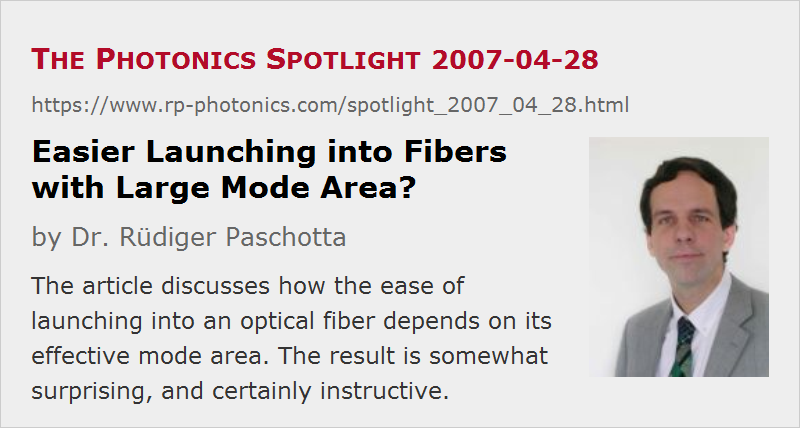Easier Launching into Fibers with Large Mode Area?
Posted on 2007-04-28 as a part of the Photonics Spotlight (available as e-mail newsletter!)
Permanent link: https://www.rp-photonics.com/spotlight_2007_04_28.html
Author: Dr. Rüdiger Paschotta, RP Photonics Consulting GmbH
Abstract: The article discusses how the ease of launching into an optical fiber depends on its effective mode area. The result is somewhat surprising, and certainly instructive.

Ref.: encyclopedia articles on large mode area fibers, single-mode fibers, multimode fibers, effective mode area
It seems to be obvious that launching into a single-mode fiber is difficult because it normally has a small effective mode area. And that the job should become easier with large mode area fibers. However, this expectation is not quite right, as long as one is dealing with single-mode fibers.
If a large mode area (LMA) fiber is supporting only a single propagation mode (per polarization direction), it will be relatively easy to hit the fiber core with an incident beam, but for efficient launching the incident beam also needs to come from quite precisely the right direction, and is therefore not necessarily easier. This essentially results from the small numerical aperture (NA), which is related to the angular acceptance.
An interesting detail is that, precisely speaking, the angular acceptance is determined by the mode area and not really by the NA. At least for a given shape of the intensity distribution of the fiber mode, the mode field distribution depends only on the effective mode area. Furthermore, the efficiency with which any incident beam can be coupled into the fiber can be calculated from an overlap integral of the two field distributions. The NA does not enter there! So a somewhat higher NA might still be compatible with single-mode guidance, but it would not make it easier to launch light into the fiber. Some common intuitive pictures can be quite misleading in this context.
This article is a posting of the Photonics Spotlight, authored by Dr. Rüdiger Paschotta. You may link to this page and cite it, because its location is permanent. See also the RP Photonics Encyclopedia.
Note that you can also receive the articles in the form of a newsletter or with an RSS feed.
Questions and Comments from Users
Here you can submit questions and comments. As far as they get accepted by the author, they will appear above this paragraph together with the author’s answer. The author will decide on acceptance based on certain criteria. Essentially, the issue must be of sufficiently broad interest.
Please do not enter personal data here; we would otherwise delete it soon. (See also our privacy declaration.) If you wish to receive personal feedback or consultancy from the author, please contact him e.g. via e-mail.
By submitting the information, you give your consent to the potential publication of your inputs on our website according to our rules. (If you later retract your consent, we will delete those inputs.) As your inputs are first reviewed by the author, they may be published with some delay.
 |





If you like this page, please share the link with your friends and colleagues, e.g. via social media:
These sharing buttons are implemented in a privacy-friendly way!